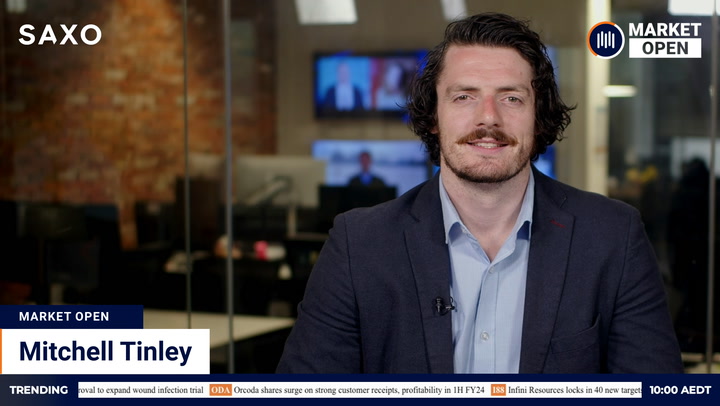Australian shares were poised to open little changed as a rebound in commodity prices helps offset losses on Wall Street after soaring inflation pointed to more aggressive rate increases.
US stocks fell for a fourth straight night. Tentative recoveries in oil, iron ore and gold helped limit downward pressure on ASX futures to four points or 0.06 per cent.
The S&P/ASX 200 is lower for the week despite two days of slim advances. The Australian benchmark edged up 15 points or 0.23 per cent yesterday.
Wall Street
US stocks fell as the hottest inflation report since 1981 stoked expectations the Federal Reserve could raise its key interest rate by up to 100 basis points this month. The main indices finished off session lows in a possible sign markets had already priced in a “hot” result.
The S&P 500 finished 17 points or 0.45 per cent lower after trading in positive territory in the second half of the session. The Dow Jones Industrial Average dropped 209 points or 0.67 per cent. The Nasdaq Composite dipped 17 points or 0.15 per cent.
The consumer price index (CPI) was 9.1 per cent higher last month than the same time last year. The surge in prices surpassed the May reading of 8.6 per cent, then the largest increase in 41 years. The result was also stronger than the 8.8 per cent median forecast among economists polled by Dow Jones.
Core CPI – the measure favoured by the Fed because it strips out volatile food and energy prices – jumped 5.9 per cent. That result was also above expectations. The Dow Jones estimate was for a rise of 5.7 per cent.
“There’s no spinning this, other than the Fed has to get more aggressive near term and crush demand. That cements a recession now,” Liz Ann Sonders, chief investment strategist at Schwab, said. “I think a recession is an inevitability.”
Futures pricing indicated traders promptly raised their bets on more aggressive rate increases. Futures tied to the federal funds target rate indicated a 59 per cent chance of a 100 bp increase when the Fed meets in two weeks, up from 10 per cent before last night’s report. Markets had previously been pricing in a 75 bp hike.
“With core [inflation] running this strong, the Fed can’t ignore that. This is a bad number,” Michael Schumacher, head of macro strategy at Wells Fargo, said.
If there was a positive for market-watchers, it was that the main indices did not sell off hard and recouped most of their losses by the close.
“You would expect the CPI that we saw would be a big risk-off event, but the market has shrugged,” Ross Mayfield, investment strategy analyst at Baird, told Reuters. Investors “were already expecting a very hawkish Fed and I don’t think this affects much except uncertainty and that has something to do with why markets aren’t selling off today.”
A mixed profit report from Delta Air weighed on the travel sector. The airline’s shares declined 4.47 per cent after adjusted earnings fell short of estimates. Rivals American Airlines and United dropped 3.11 and 0.84 per cent, respectively. Cruise lines also retreated.
The second-quarter corporate reporting season gathers steam tonight with updates from JPMorgan and Morgan Stanley. Wells Fargo and Citigroup report tomorrow.
Australian outlook
Another neutral start coming up – the third in a row this week. That is bad news for volatility-hungry traders, but not necessarily negative for investors with a longer perspective. The market has settled down noticeably over the last few weeks in a possible sign much of the known negatives about this year’s outlook have been priced in.
Wall Street fell overnight, but the reaction was muted compared to the responses to previous “hot” inflation reports. A month ago the S&P 500 tumbled 3.9 per cent when inflation hit 8.6 per cent. Next day, the ASX 200 sank 3.6 per cent.
Last night, US inflation topped 9.1 per cent and the market heard the Fed might rise its key rate by an earth-shaking 100 basis points. The reaction? The S&P 500 dipped a mere 0.45 per cent. There is a message there.
The S&P/ASX 200 has held its ground fairly well this week while US stocks have fallen. The Australian benchmark has risen for two sessions despite pressure on major exports. Those pressures eased overnight, albeit with prices at significantly lower levels (see below).
A week dominated by overseas risk events gives way to domestic concerns this morning with the 11.30 am AEST release of June employment data. Economists anticipate a drop in the jobless rate to 3.8 per cent from 3.9 per cent in May as the economy adds around 30,000 new jobs.
US sector action was broadly negative. Perhaps oddly in the light of consumer pricing pressures, the only sectors to advance were consumer-focussed. Discretionary stocks gained 0.86 per cent. Staples inched up 0.01 per cent.
Industrials sank 1.2 per cent, financials 0.93 per cent, materials 0.55 per cent and energy 0.14 per cent.
IPOs: this week’s only new listing is scheduled to take place at 2.30 pm AEST. Botala Energy is a Perth-based explorer with a gas project in Botswana.
The dollar firmed 0.19 per cent this morning to 67.59 US cents.
Commodities
Strong Chinese trade data helped commodity markets steady after days of volatile losses. Chinese exports increased last month at the strongest pace in five months. The government continued to talk up support for the economy.
The most-traded iron ore contract on the Dalian Commodity Exchange bounced 1.5 per cent to 732 yuan after hitting its lowest level since late February. The spot price for ore landed at Tianjin climbed US$2.07 or 1.9 per cent to US$110.26 a tonne.
Mining giants BHP and Rio Tinto rose in US trade. BHP‘s US-traded depositary receipts edged up 0.2 per cent after its UK listing declined 0.92 per cent. Rio Tinto climbed 1.54 per cent in the US and 0.25 per cent in the UK.
Oil prices steadied below US$100 a barrel after freefalling for several sessions. Brent crude settled eight US cents or 0.1 per cent ahead at US$99.57 a barrel. The US benchmark firmed 46 US cents or 0.5 per cent to US$96.30 despite a second straight weekly increase in US stockpiles.
Brent skidded more than 7 per cent on Tuesday as creeping Covid restrictions in China sharpened fears of another lockdown. WTI fell almost 8 per cent.
“Brent is in oversold territory at the moment, and the fundamentals do not justify the scale of the selloff we have seen in recent weeks. The oil market is still tight, as reflected in the prompt Brent spread. The outlook is for this tightness to persist,” Warren Patterson, head of commodities strategy at ING, wrote.
Gold miners rallied in the US as a pullback in the greenback buoyed precious metals. Gold for August delivery settled US$10.70 or 0.6 per cent ahead at US$1,735.50 an ounce. Silver gained 1.2 per cent. The NYSE Arca Gold Bugs Index bounced 2.66 per cent.
US copper rebounded despite on-going pressure on the London Metal Exchange. On Comex, copper firmed three US cents or around 1.1 per cent to US$3.3225 per pound.
Benchmark copper on the LME eased 0.3 per cent to US$7,310.50 a tonne. Aluminium dipped 0.2 per cent, nickel 1.1 per cent, lead 0.1 per cent, zinc 2.7 per cent and tin 0.6 per cent.





